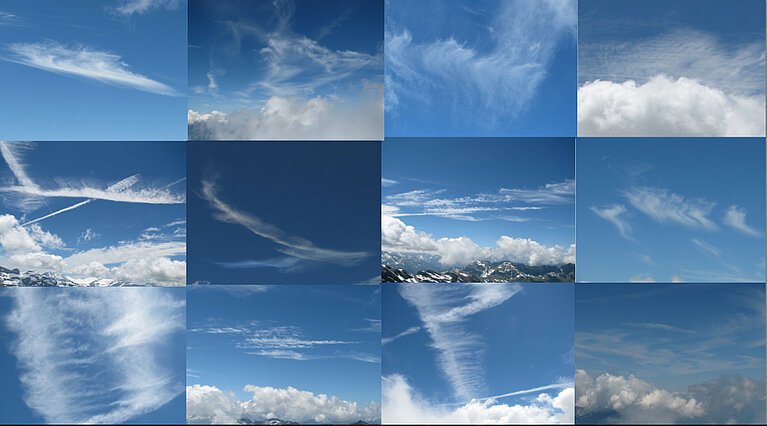July 4, 2016 - by Simone Ulmer
Cirrus clouds look like giant feathers wandering around the blue sky; In fact, they consist of numerous tiny ice crystals. They form in our latitudes at heights of 5-13 km, where temperatures can be as low as -70°C. Although they may seem light as a feather and translucent, these clouds contribute to the greenhouse warming effect of Earth's atmosphere. This is because incoming short-wave solar radiation easily passes through the thin cirrus clouds, while they block a large fraction of outgoing long-wave terrestrial radiation.
The interaction of cirrus clouds with radiation is a complex one, which depends on the concentration of ice crystals, their size, as well as on properties such as the temperature of the cloud and the underlying surface, and solar insolation. Model calculations indicate their radiative effect accounts for about 5 Watts per square meter in global average. “Were one to eliminate all cirrus clouds, that would immediately counteract a CO2 doubling which adds a ‘warming’ impact of 3.7 Watts per square meter”, says atmospheric physicist Ulrike Lohmann of ETH Zurich. This is what makes cirrus clouds a potential target for geoengineering methods.
Geoengineering by means of larger ice crystals
An ideal geoengineering scheme would dissolve the cirrus clouds completely or prevent their formation in the first place. This, however, is not possible. Nevertheless, their radiative effects could be reduced by seeding them with some very effective ice nucleating particles. These ice nucleating particles are thought to decrease the number of ice crystals in the cirrus cloud and make the remaining ones larger. This would allow more long-wave radiation to escape to space, decreasing their warming impact on climate. The effectiveness of such measures has now been investigated by Lohmann and her graduate student Blaž Gasparini using simulations with the ECHAM6-HAM global climate model on the CSCS supercomputer ‘Piz Daint’.
A key issue that needs to be addressed to understand the efficacy of geoengineering, says Gasparini, is whether a cirrus cloud and its ice crystals have formed heterogeneously or homogeneously. Heterogeneously formed ice crystals develop on a solid particle, called an ice nucleating particle, such as a grain of dust. On the other hand, water droplets or sulphuric acid droplets lead to homogeneously formed cirrus clouds. Only these homogeneously formed cirrus clouds can be effectively influenced by artificial ice nucleating particles, ideally at locations where the humidity is relatively high and the cirrus clouds are still in the process of formation.
To date there exists only three studies on this topic, says Lohmann. These offer some hope that the radiation effect induced by cirrus clouds could be cut by 2 watts per square metre – which is to say, up to 40 percent of their estimated overall effect. However, the simulations by Gasparini and Lohmann on the CSCS supercomputer ‘Piz Daint’ paint a less optimistic picture. Their simulations show that only a small fraction of cirrus clouds has been formed homogeneously and is therefore susceptible to artificial seeding. Furthermore, it was found that more cirrus clouds formed under the influence of artificial ice nucleating particles and, rather than increasing, the diameter of their ice crystals actually decreased. Their conclusions show no significant effects of cirrus cloud seeding on climate.
More data needed
Gasparini and Lohmann note that their model predicts more heterogeneously formed cirrus clouds, and also a larger radiative warming effect from remnants of thunderstorm clouds, compared to previous studies. These so-called anvil cirrus clouds, say the researchers, have similar radiative effects to locally-formed cirrus clouds but cannot be influenced by introduction of artificial ice nucleating particles in these altitudes. Due to the lack of studies as well as the uncertain data available on the global distribution of cirrus clouds, Lohmann admits that the results currently obtained in this area are contradictory and will remain so for the time being. The researchers advocate for better observational data of the properties of cirrus clouds and ice crystal formation mechanisms to improve their computer models and strengthen the results of their modelling.
Reference
Gasparini B, and Lohmann U: Why cirrus cloud seeding cannot substantially cool the planet, J. Geophys. Res. Atmos. (2016), 121, doi:10.1002/2015JD024666.
